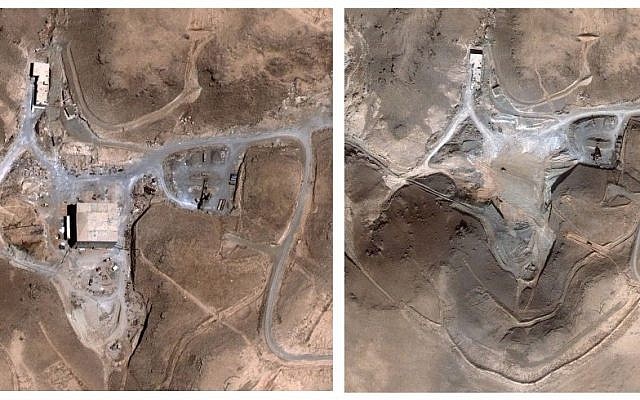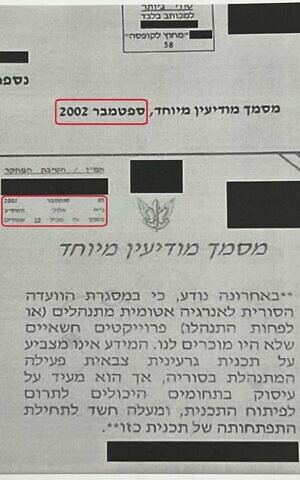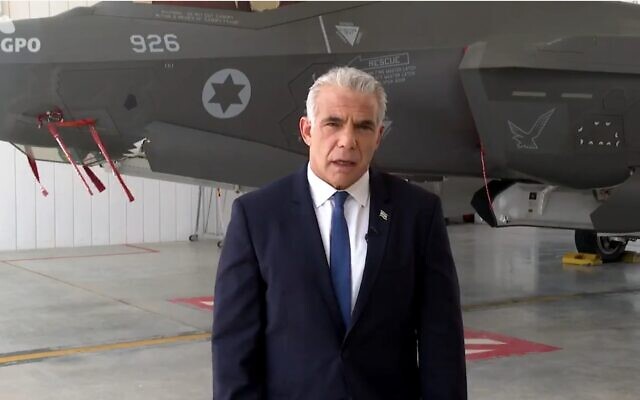Declassified top-secret paper shows Israel knew Damascus was seeking to develop military nuclear abilities earlier than previously thought

The Israel Defense Forces on Tuesday published a never-before-seen internal document from 2002, in which the Military Intelligence Directorate warned Syria could be attempting to begin a military nuclear program.
The intelligence assessment was put together five years before Israel eventually struck a secret Syrian nuclear reactor being built in the area of Deir Ezzor on September 6, 2007, in a mission known as Operation Orchard.
The publication came 15 years after the major airstrike that effectively destroyed Syria’s nuclear program. Earlier Tuesday, Prime Minister Yair Lapid, standing next to an F-35 fighter jet, warned Iran that Israel would act to prevent it from becoming a nuclear state, amid a possible nuclear agreement between Tehran and world powers.
“Recently it became known that secret projects previously unknown to us are being conducted (or at least were being conducted) within the framework of the Syrian Atomic Energy Commission,” the cover sheet of the top-secret document from September 2002 read.
“The information does not indicate an active military nuclear program underway in Syria, but it does indicate an interest in areas that can contribute to the development of a program, and raises suspicions of the beginning of the development of such a program,” the document added.
Until the publication Tuesday, the earliest suspicions Israel had acknowledged of a Syrian nuclear program were in 2004, when it said Military Intelligence and the Mossad espionage service began receiving unverified information about foreign experts helping Syria develop a military nuclear program.
The scanned cover sheet of another top-secret IDF document from 2004 showed that Israeli intelligence suspected the experts were coming from North Korea, Pakistan, or a third, unknown, country.

It is now known that North Korea had been working with Syria on the nuclear program since at least 2001 or 2002, as accounts differ on the exact start time.
For the next year and a half, the army and Mossad collected information concerning the Syrian nuclear program, getting their first break in January 2006, when they found the first piece of “substantial evidence” that Syrian President Bashar Assad was building a reactor.
In early March 2007, the investigation had a breakthrough. Mossad agents obtained pictures that were shot inside suspicious buildings at a site in the northern Deir Ezzor region that it designated “Rubik’s Cube,” including ones showing North Korean officials at the site. The photographs confirmed Israel’s suspicions that a plutonium reactor was under construction at the site.
At this point, Israel decided to bring the United States into the loop. However, the US was not entirely convinced that the reactor was actually capable of producing nuclear weapons and therefore wanted to address the issue diplomatically, according to former US president George W. Bush’s memoirs.
Then-prime minister Ehud Olmert was concerned that Assad would stall the potential negotiations for long enough for the Syrians to bring the reactor online, and told Bush his “strategy is very disturbing to me.”
On September 5, 2007, the security cabinet approved Olmert’s plan for an immediate attack, giving him, then-defense minister Ehud Barak, and then-foreign minister Tzipi Livni the authority to decide when exactly to conduct the strike.
Gabi Ashkenazi, the IDF chief of staff at the time, called for the attack to happen that night. At approximately midnight on September 6, fighter jets reached their target and dropped tons of explosives on the site, destroying it.
According to Israeli and American intelligence, the Deir Ezzor site, known in Syria as al-Kibar, contained a gas-cooled, graphite-moderated reactor that was capable of producing weapons-grade plutonium, similar to North Korea’s Yongbyon nuclear facility. It was close to being up and running when Israel destroyed it in Operation Orchard.

Speaking at the Nevatim airbase on Tuesday, Lapid warned: “If Iran continues to test us, it will discover Israel’s long arm and capabilities. We will continue to act on all fronts against terrorism and against those who seek to harm us.”
Israel has been pressuring the US not to reenter the 2015 nuclear accord which was abandoned in 2018 by President Joe Biden’s predecessor Donald Trump. Biden took office aiming to revive the deal.
The US said last week that Iran’s latest proposals in nuclear negotiations were “not constructive,” after the sides had seemed on the verge of reaching a deal.
A senior defense official said last month that Israel had two main issues with the emerging deal: the so-called sunset clause, which would lift limitations on Iran’s nuclear program when the accord expires; and sanctions relief that would allow Iran to increase funding to its proxies.
Israel has also pushed the US to prepare a military option against Iran, and US President Joe Biden said in July that he would be prepared to use force if necessary to prevent Iran from obtaining a nuclear weapon.
Unlike Syria’s, Iran’s nuclear program is believed to be too advanced to be taken out with one strike and it is unclear how much damage a military attack would be able to do.
As reported by The Times of Israel
